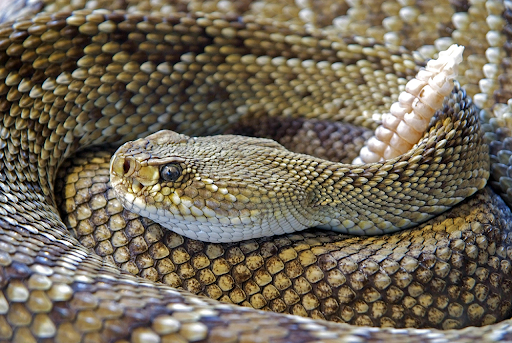Few things are more terrifying than discovering your dog or cat has encountered a snake.
Whether you’re hiking mountain trails, walking through suburban neighborhoods, or simply letting your pet explore your backyard, snake encounters can happen anywhere—and when they do, knowing how to respond can literally save your pet’s life.
Warm weather brings increased snake activity in many regions, making it crucial to understand both prevention strategies and emergency response. Snake bites are true veterinary emergencies that require immediate professional care, but there are important steps you can take to protect your furry family member and respond effectively if the worst happens.
Know Your Risk: Understanding Snake Behavior and Habitats
Snakes are most active during warm months, particularly in late summer when temperatures are high but not extreme. They seek shelter in cool, dark places during the heat of the day—under decks, in woodpiles, rock formations, tall grass, and even garden sheds. Unfortunately, these are also places where curious pets love to explore.
Most snake bites occur when pets surprise or corner snakes, triggering their defensive response. Dogs are more commonly bitten than cats, typically on the face, neck, or legs as they investigate something interesting with their nose or paws. Cats, being more cautious by nature, are less frequently bitten but aren’t immune to encounters.
The key to prevention lies in understanding that snakes don’t actively hunt pets—they bite in self-defense. This means most encounters are preventable through smart environmental management and pet supervision.
Prevention Strategies That Actually Work
Creating a snake-safe environment starts with your property. Keep grass cut short, remove brush piles and debris where snakes can hide, and seal gaps under decks or sheds. Install snake-proof fencing around high-risk areas like gardens or dog runs. Mesh fencing that extends underground can effectively deter many of these reptiles.
When walking or hiking with your pet, stick to well-maintained trails and avoid tall grass, rock piles, or areas with dense vegetation. Keep your dog on a short leash and discourage them from investigating holes, logs, or dark spaces where snakes might shelter. During peak snake season, be extra vigilant during dawn and dusk walks when snakes are most active. If you live in a high-risk area, consider investing in protective gear like snake-proof vests or gaiters designed for dogs.
Training can also be invaluable. Teaching your dog a reliable “leave it” command and recall can prevent them from approaching potential snake habitats. Some pet parents find success with snake avoidance training, though this should always be conducted by qualified professionals using humane methods.
Remember that even non-venomous snake bites can cause serious infections and require veterinary care. The goal isn’t just avoiding venomous species—it’s preventing all snake encounters whenever possible.
Emergency Response: What to Do When a Bite Occurs
If you witness or suspect a snake bite, every second counts. The most important thing to remember is this: get to veterinary care immediately. Don’t waste precious time trying to identify the snake species or attempting home remedies. Professional treatment is the only effective response to snake bites.
Here’s what to do in the critical moments after a bite:
Immediately: Keep your pet calm and still. Carry them if possible rather than letting them walk, as movement can spread venom more quickly through their system. Remove any collars or harnesses that might restrict breathing if swelling occurs.
Don’t: Cut the bite wound, apply ice, use a tourniquet, or give any medications. These outdated “remedies” can actually worsen the situation and delay proper treatment.
Do: Take a photo of the snake if you can do so safely from a distance, but never risk your own safety or delay seeking care to identify the species. Try to note the time of the bite and any immediate symptoms you observe.
Seek veterinary care immediately. This cannot be overstated—snake bite treatment is most effective when administered quickly, ideally within the first few hours after the incident.
Recognizing Snake Bite Symptoms
Snake bite symptoms can vary dramatically depending on the species, amount of venom injected, and your pet’s size and health status.
Venomous bites often cause rapid onset of symptoms that include:
- Swelling at the bite site
- Difficulty breathing
- Drooling
- Vomiting
- Weakness
- Collapse
Note that some bites may show delayed symptoms or minimal immediate effects.
Non-venomous bites typically cause puncture wounds and may result in swelling, pain, and potential infection. Even without venom, these bites require professional evaluation and treatment to prevent complications.
The challenge is that you often can’t immediately determine whether a bite was venomous or not. That’s why every suspected snake bite should be treated as a potential emergency requiring immediate veterinary care.
Seek Immediate Care
Time is absolutely critical with snake bites, so don’t second-guess yourself or wait to see if symptoms develop. The sooner treatment begins, the better your pet’s chances of a full recovery.
AcutePet is open 7 days a week from 10 AM to 10 PM, with summer holidays offering limited hours of 10 AM to 4 PM. You don’t have to wait for your regular veterinarian or scramble to find emergency care–our team is here to act fast. Our experienced veterinarians are trained to quickly assess snake bite cases and provide the right treatment, including antivenom when needed.
If you think your pet may have tangled with a snake, call or head to AcutePet right away. With same-day appointment availability and walk-in options, we’ll be ready when every minute counts.
